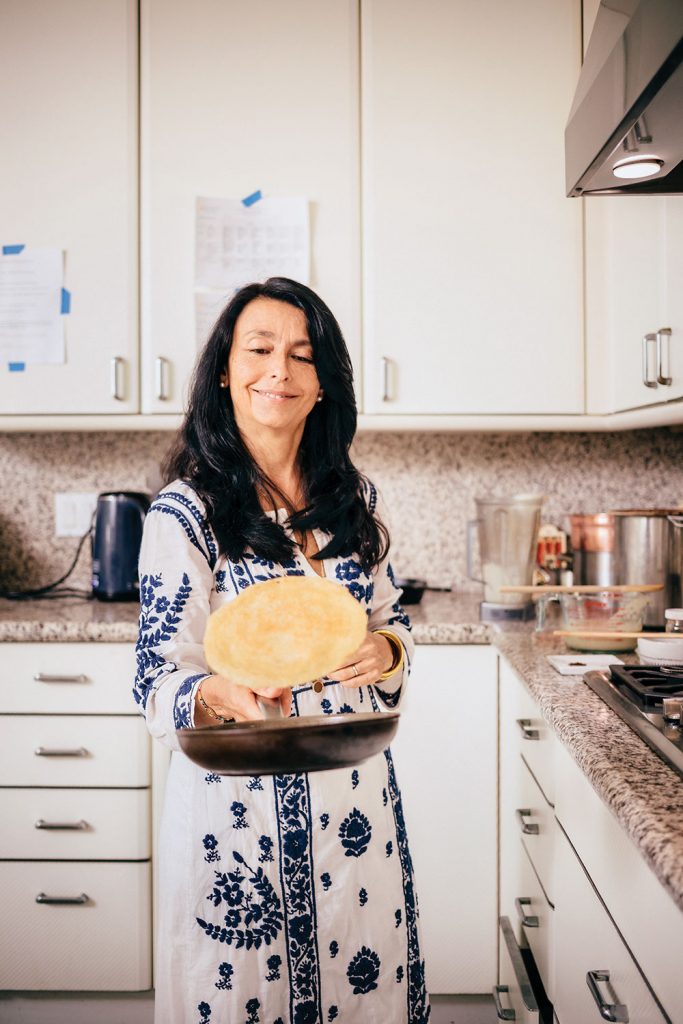
STORY BY MELANIE RUD ✷ PHOTOGRAPHS BY JONAS JUNGBLUT
“Now, please text me a photo of your tongue.”
This was the first thing Martha Soffer said to me when we met via Zoom. While tongue selfies are an admittedly strange concept for most, it’s par for the course for Martha, one of the most renowned Ayurvedic doctors and experts in the country. The tongue, as she explained while I struggled to snap a photo of my own, is a visual representation of what’s happening internally in our bodies, a key diagnostic tool in Ayurvedic medicine.
But, what exactly is Ayurveda? Simply put, it’s a centuries-old healing science that emphasizes balance, both within the individual self and with nature. “Ayurveda translates to ‘the science of life,’” Martha explains. It’s an umbrella philosophy that can impact our lives in so many ways, ranging from improving our daily routines to healing major illness, she adds.
For this Columbian-born practitioner, Ayurveda is an extension of her childhood. She grew up surrounded by natural medicine, with a grandmother who relied on a garden full of plants and herbs to treat every ailment. Despite this, Martha never thought she’d end up in a field even remotely related to holistic medicine. She moved to the U.S. to study computer science, where she stumbled upon Ayurveda completely randomly. “I happened to sit next to a woman in the dining hall who had just come from an Ayurvedic treatment,” she says. “She smelled like these amazing oils and the more I asked her about it, the more fascinated I became that there was something out there that could make you feel so amazing.”



This fortuitous meeting inspired Martha to begin her Ayurvedic training, thus kick-starting her career trajectory. “Everything collided perfectly for me,” says the doctor. “I could feel that nature was supporting me.”
She opened the renowned Surya Spa, an Ayurvedic clinic in Los Angeles nearly two decades ago, a destination for her devoted clients who flock from around the world to experience healing treatments. She’s now poised to open Surya Santa Monica in the Proper Hotel next year. The new clinic, designed by Kelly Wearstler, will be the first of its kind open to the public, and will offer, among other things, classes, treatments, and gourmet Ayurvedic food at the in-house restaurant.
Speaking of, food and diet are one of the most important pillars of Ayurvedic living. “Food is a huge component of Ayurveda, truly exemplifying the ‘you are what you eat’ mentality,” says Martha. “We want to teach people to learn what is happening with their bodies, and then be able to use food as medicine.”
Ayurveda revolves around the concept that each individual has one of three biologic energies or doshas—vata, pitta, and kapha—which govern both our physical and emotional self. Each of these is associated with an element—vata with wind, pitta with fire, and kapha with earth. According to Ayurveda, ailments or illness are a sign that your dosha is imbalanced. Per the food as medicine concept, an Ayurvedic diet centers around eating foods that will keep your dosha balanced.
Going back to my own consultation with Martha, she quickly diagnosed my dosha as pitta. As such, my dietary recommendations were to avoid spicy and inflammation-inducing foods, which would only further my internal heat, and instead eat cooling foods such as watermelon and cucumber.




While it can be hard to determine your dosha without the assistance of an Ayurvedic practitioner, there are certain Ayurvedic food and diet principles that are universally beneficial. First and foremost, eat seasonally, meaning not only foods that are in season, but also ones that are in line with the weather. “Eat cooling foods during the summer, then switch to warmer, more nourishing foods in the fall and winter,” Martha explains.
Secondly, make eating a singular activity; multitasking during meals is a no-no. According to Martha, something as simple as taking 10 minutes to just eat, without email, TV, or texting can have a hugely positive impact.
Finally, incorporate more of the foods widely considered in Ayurveda to be good for all individuals, regardless of one’s specific dosha. Of these, ghee (a type of clarified butter) is perhaps one of the most powerful, with the ability to bind to and help move toxins through and out of your body, she explains. (Keep reading for three of Martha’s Ayurvedic recipes that rely on more of these foods.)
But back to our Zoom call. Soffer was indeed able to pinpoint several specific physical ailments of mine, simply based on that tongue selfie. That was enough to convince me that it was worth trying her personalized recommendations. As mentioned, I bid farewell to my beloved hot sauce collection and plowed through bowls of watermelon in an attempt to help keep my pitta-self more balanced. I made a conscious effort to do nothing else while eating, a task much easier said than done for someone who thrives on juggling.
Along with diet, topical oils are a mainstay of Ayurvedic healing; Martha sent me several specially concocted to address my dosha and individual needs, accompanied by explicit instructions as to how to perform an oil massage, similar to ones offered at Surya.
“Everything collided perfectly for me. I could feel that nature was supporting me.”
The results? Making even these few minor changes yielded a big result. My skin (which is often the first place to show signs of an imbalanced dosha) was clearer and brighter. I felt less sluggish when I woke up. I could go a solid seven minutes while eating without checking my phone—what can I say, I’m building up to ten—during which I realized just how much of a sensory experience eating really is.
And while I have no doubt that the oil massages would be much more enjoyable if they weren’t self-administered, they’ve become a new self-care ritual that I greatly look forward to. At the end of the day, incorporating these simple Ayurvedic principles into my day-to-day life is proof positive that there’s good reason why people have relied on this healing science for centuries—and that even small changes can have a big impact.

MARTHA’S TOP 10 AYURVEDIC LIVING TIPS
Steer clear of night shades such as bell peppers, potatoes, and tomatoes. They contain molecular nicotine, which is why they’re so addicting. If you do want to eat tomatoes, dip them in hot water and remove the skin and seeds to lower the acidity. Avoid any potatoes that have a greenish hue.
Incorporate all six tastes into your meals: sour, salty, pungent, sweet, bitter, and astringent to activate different areas in the tongue. This stimulates the organs and helps balance the body.
Feeling stressed? Take one teaspoon of ghee on an empty stomach every morning; it helps pull toxins from your tissues and centers the mind.
Avoid acidifying foods such as chocolate, onions, garlic, fermented foods, mushrooms, peanut butter, and processed meats, all of which create inflammation.
Use healthy fats such as ghee, coconut oil, or grapeseed oil for cooking, and only olive oil for raw preparations in order to minimize inflammation.
Take an ocean mineral supplement every day. Oceanic trace minerals help to restore electrolyte balance, increase absorption of nutrients from your food, and strengthen your immune system.
Scrape your tongue daily. It’s one of the most important Ayurvedic self-care practices and can help get rid of toxins.
Don’t drink a lot of water right before a meal. It dilutes your digestive enzymes and dampens digestive fire, making it more challenging for your body to break down food. Instead, sip small amounts of water during your meal.
Drink radish tea to help with weight loss and thyroid balance. Radishes are pungent, sweet, and bitter, so they help clean the liver and reduce bilirubin. Chop one to two red or black radishes and add to three to four cups of hot water. Let steep for one to two hours and drink throughout the day.
If you’re having trouble sleeping, Martha suggests massaging your feet with ghee to soothe the nervous system and help calm a busy mind.

Surya Detox Tea
Serves 1
“A simple, delicious tea made from three seeds, this helps settle the stomach, eases digestion, and aids kidney and blood detox. In Ayurveda, good digestion is the foundation for overall health, so sipping on this tea is a nourishing and easy way to support your wellbeing.” –Martha
Gather
1 teaspoon cumin seeds
1 teaspoon coriander seeds
1 teaspoon fennel seeds
To Make
Place seeds in the bottom of a mug and pour hot water over them.
Allow tea to steep for three minutes before drinking.

Mung Bean Pancakes
Serves 2
“This is a high-protein meal that makes use of mung beans’ many benefits—they’re easily digested, highly nutritious, and naturally detoxifying. These pancakes are satiating, easy to make, and tridoshic, meaning they balance any constitution. Try them topped with a little coconut yogurt and a drizzle of coconut nectar.” –Martha
Gather
2/3 cup organic mung beans
1/3 cup organic basmati rice
1 organic apple, pear, mango or berries
1/8 teaspoon cinnamon
1 tablespoon coconut syrup
To Make
The day or night before you intend to eat these pancakes, wash the mung beans and the rice well. Mix together with hot water to cover and let soak overnight. Make sure there’s room in the container you’re using (a canning jar works well) for the mixture to expand. (If using a canning jar, cover it with the lid, but don’t screw the lid on.)
In the morning, dump out the water and rinse the rice and mung beans well. Add fresh water, filling the jar up to just under the grain mixture.
Combine the grains, water, and cinnamon in a blender and blend until it becomes a batter. Set aside.
Add sliced fruit and some coconut oil, ghee, or water to a frying pan. Simmer the fruit until it’s cooked all the way through.
In a separate pan, heat up a little coconut oil and cook the batter like a pancake.
Top the pancake with the cooked fruit and the coconut syrup, if desired.*Note: Leftover batter can be saved in the refrigerator for another day.

Morning Rice Cereal
Serves 1
“This nourishing, gluten-free, and comforting breakfast cereal is filled with good proteins and fats from nuts and nut milk, and gives you sustained energy. In Ayurveda it’s important to start the day with warm, light foods to gently awaken the ‘agni,’ or digestive fire. It can easily be modified depending on what your body needs each day—add extra nuts for grounding, apples for cooling, or warming spices like ginger and cinnamon for an energy boost.” –Martha
Gather
½ cup organic brown rice
3 cups water
1 handful almonds
½ cup hot water
½ cup chopped fruit of your choice
To Make
Wash the rice thoroughly and add to a pot with the 3 cups of water. On high heat, bring the water to a boil and let the water continue boiling until it is the same height as the rice. Turn the heat down to low and cover until cooked, about 10 minutes. (Alternately, cook rice in a rice cooker.)
While the rice is cooking, blend the almonds with the hot water to make your almond milk; you should have about ¾ of a cup.
Once the rice is cooked, add the almond milk and fruit, then continue cooking until the fruit is cooked. If desired, top with a dash of cinnamon and some chopped walnuts or macadamia nuts.









